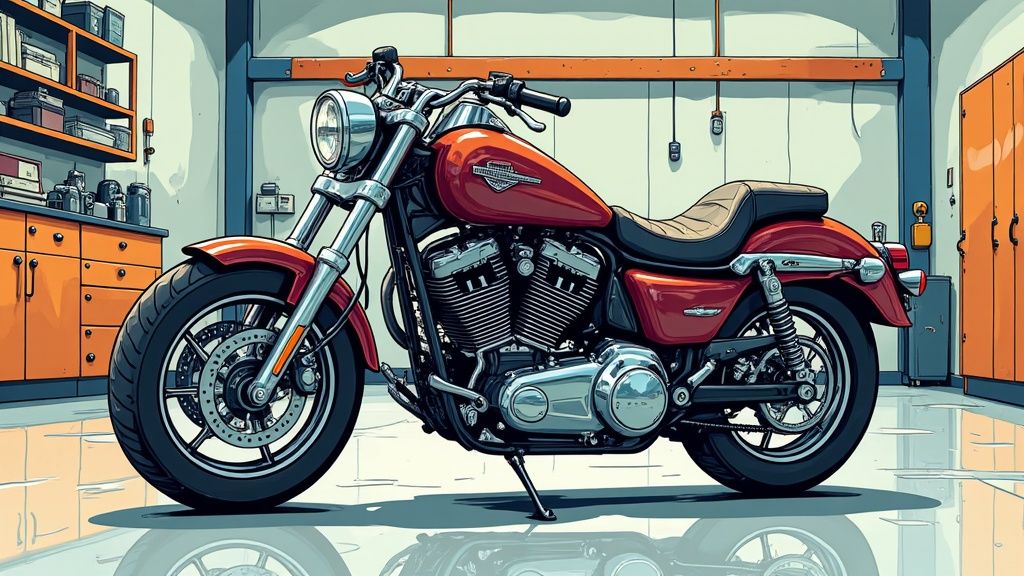
Harley Davidson Maintenance Schedule: Expert Tips
Why Your Harley-Davidson Maintenance Schedule Matters
Riding your Harley, feeling the wind in your face and the rumble of the engine, is the ultimate experience. But that exhilarating freedom depends on something less glamorous: proper maintenance. It’s the unsung hero behind every unforgettable journey.
Maintaining your Harley isn’t about obsessive tinkering. It’s about understanding how your bike works and keeping it in top condition. Think of your engine like your heart—it needs clean oil and regular checks to stay strong. Your brakes are your lifeline, demanding consistent attention for optimal performance. This care creates a deeper connection between you and your machine. You learn its rhythms, understand its needs, and ensure it runs smoothly for years to come.
The Impact of Routine Care
A well-maintained Harley provides more than just peace of mind. It directly affects the lifespan of your bike, allowing you to enjoy countless rides for years to come. Regular care also maximizes performance, delivering that signature Harley power and responsiveness every time you hit the road. Plus, a documented maintenance history significantly increases resale value, attracting buyers who appreciate a well-cared-for machine. Your Harley becomes not just a passion, but a wise investment.
Speaking of smart investments, following the Harley-Davidson maintenance schedule is crucial. These schedules are created for optimal performance and longevity. Key service intervals occur at 1,000, 5,000, 10,000, and 20,000 miles.
These services include essential tasks:
- Oil changes
- Air filter inspections
- Transmission lubrication
Even seemingly small checks, like monitoring brake fluid levels annually, can prevent major problems down the line. Learn more about Harley-Davidson maintenance schedules at Rommel Harley-Davidson of Delmarva. Ignoring these vital checks can result in expensive repairs, such as engine overhauls from insufficient oil changes.
Preserving the Legend
A Harley-Davidson is more than a motorcycle; it’s a legacy. It’s a machine built to last, meant to be passed down. By understanding and following the Harley-Davidson maintenance schedule, you’re not just maintaining your bike; you’re preserving a piece of American history.
This commitment to care ensures your Harley continues to roar, providing that unmatched riding experience for decades to come. It’s an investment in the future of your machine and a tribute to the enduring spirit of Harley-Davidson.
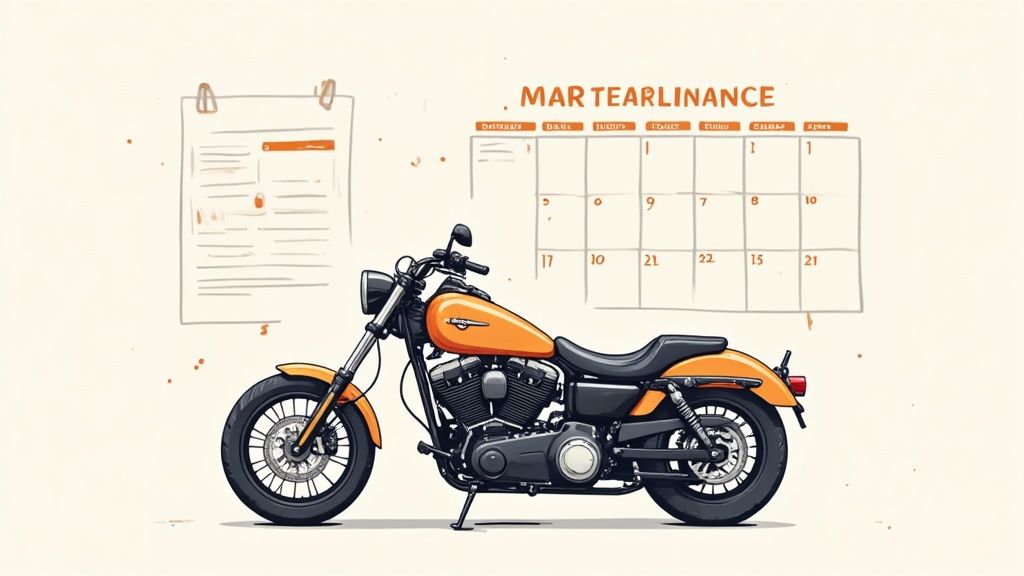
Keeping Your Harley Roaring: Essential Service Milestones
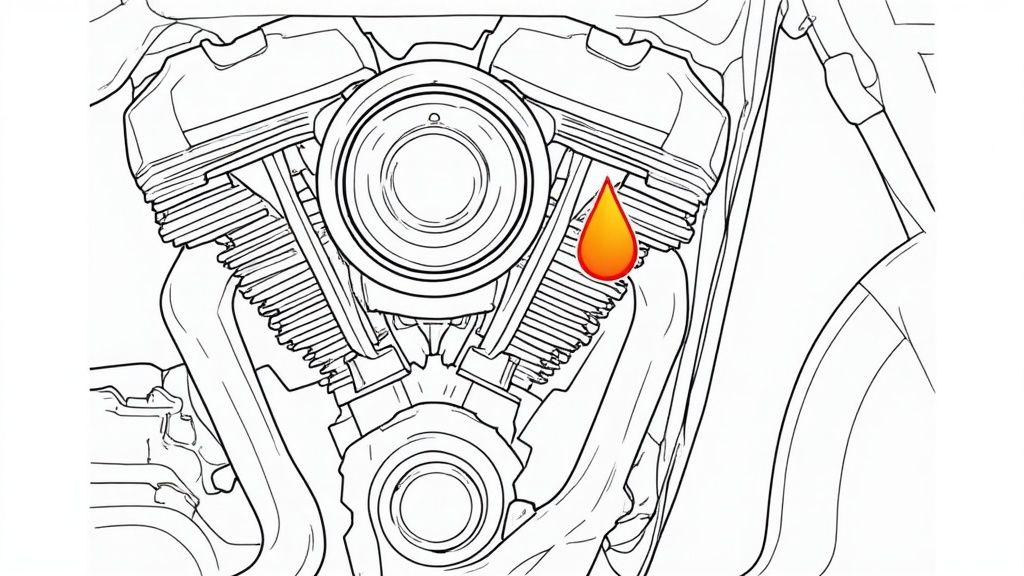
That unmistakable rumble of a Harley-Davidson engine is a thrill every rider cherishes. Maintaining that powerful performance, however, requires a proactive approach to maintenance. Understanding your Harley’s service schedule is key to keeping it in top condition for years to come. Let’s explore the essential service milestones and why they’re vital for your bike’s health.
The 1,000-Mile Mark: First Check-Up
The first 1,000 miles are crucial for your Harley. This initial service acts as a comprehensive check-up after the break-in period. It’s an opportunity to identify and address potential issues that might not be obvious to the untrained eye. This first service sets the foundation for a long and healthy life for your motorcycle.
This service typically involves an oil and filter change, essential for removing any metal shavings from the initial engine wear. Technicians also inspect vital components such as brakes, cables, and the drive belt, ensuring they function correctly. This attention to detail ensures thousands of trouble-free miles.
The 5,000-Mile Check: Preventing Problems
At 5,000 miles, more in-depth preventive maintenance is required. This service goes beyond the basics, tackling the wear and tear that accumulates with regular riding. The air filter, crucial for clean engine operation, is inspected and replaced if necessary.
Spark plugs are also checked, and the primary drive chain case oil is changed. This service is vital for preventing minor issues from becoming major, costly repairs. It’s a tune-up to keep your Harley performing at its best.
The 10,000-Mile Service: Mid-Point Maintenance
The 10,000-mile mark signifies a significant milestone. This service is more extensive, including all the checks performed at the 1,000 and 5,000-mile services, plus additional inspections of critical systems. Brake fluid is changed for optimal braking performance, and the transmission lubricant is replaced to ensure smooth shifting.
This mid-point rejuvenation maintains your bike’s performance and prevents premature wear on vital components. It’s an investment in your Harley’s long-term health and reliability.
The 20,000-Mile Overhaul: Complete Assessment
The 20,000-mile service is the most comprehensive in the Harley-Davidson maintenance schedule. It’s a complete health assessment, covering every major system. This service often includes adjusting the valves for optimal engine performance and efficiency.
The fuel filter is replaced, and the entire bike undergoes a thorough inspection to identify any potential problems. This extensive service is essential for maintaining your Harley’s long-term reliability and preventing costly breakdowns.
To help you keep track of all these vital service intervals, we’ve compiled a handy table below:
Harley Davidson Major Service Intervals A comprehensive breakdown of required maintenance tasks at key mileage points
| Mileage Interval | Required Services | Estimated Time | Importance Level |
|---|---|---|---|
| 1,000 miles | Oil & filter change, brake inspection, cable inspection, drive belt inspection | 2-3 hours | Critical |
| 5,000 miles | Air filter inspection/replacement, spark plug check, primary drive chain case oil change | 3-4 hours | High |
| 10,000 miles | All 1,000 & 5,000-mile service checks, brake fluid change, transmission lubricant change | 4-5 hours | High |
| 20,000 miles | All previous checks, valve adjustment, fuel filter replacement, comprehensive inspection | 6-8 hours | Critical |
This table provides a general overview. Always consult your owner’s manual for the specific requirements for your model year. Proper documentation is essential; learn how to manage your service records effectively. This diligent approach to maintenance ensures your Harley is ready for countless more miles of open road adventures. By understanding and adhering to these service milestones, you’re not just maintaining your Harley—you’re investing in its longevity and performance.
Beyond The Basics: Components That Demand Your Attention
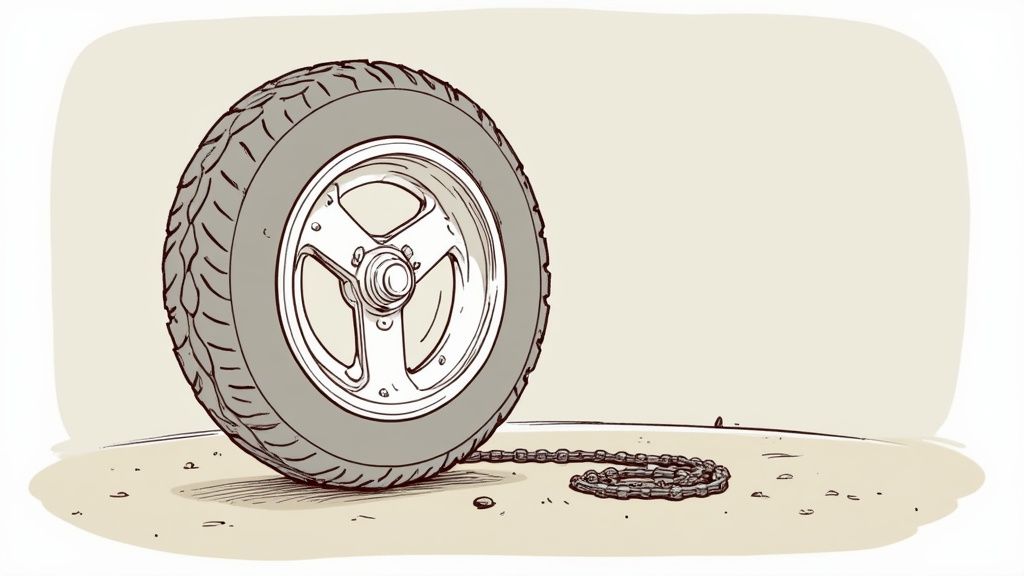
While regular oil changes and other basic checks are essential, your Harley-Davidson requires specialized care for certain components. These often overlooked systems are vital for keeping your bike running smoothly. This includes paying close attention to the primary drive, transmission, brakes, and electrical system. Understanding their function and maintenance needs is key to enjoying countless miles on the open road.
The Heart Of Power Transmission: Your Primary Drive
The primary drive is the muscle behind your Harley, transferring power from the engine to the transmission. Whether chain or belt driven, this system requires regular inspection and lubrication. A loose chain can cause significant damage, while a cracked belt can leave you stranded. Recognizing these warning signs is critical for a reliable ride.
Shifting Gears Smoothly: Transmission Care
Your Harley’s transmission is a complex system responsible for smooth shifting and optimal power delivery. Regular fluid changes and inspections are crucial. This involves checking for leaks and ensuring proper fluid levels. Neglecting this system can lead to clunky shifts, reduced performance, and costly repairs.
Stopping Power: Maintaining Your Brakes
Your brakes are arguably the most important system on your motorcycle. Regular inspection goes beyond checking pad thickness. Inspecting brake lines, fluid levels, and overall system integrity is paramount. Worn brake lines can reduce stopping power, compromising your safety.
The Electrical Pulse: Keeping It Charged
Modern Harleys rely heavily on their electrical systems. Maintaining the battery, charging system, and all wiring is more critical than ever. Corrosion, loose connections, and aging wiring can cause various problems. Regular checks and preventative maintenance can avoid these issues.
Regular maintenance, such as replacing spark plugs every two years or 30,000 miles and the fuel filter every 100,000 miles, is crucial. Regularly inspecting fuel lines minimizes mechanical failures and keeps your Harley in peak condition. For more detailed maintenance information, consult this helpful resource.
To better understand maintenance intervals and the potential issues arising from neglect, refer to the table below. It provides a helpful overview of key components and their recommended replacement schedules.
Component Replacement Schedule
Timeline for replacing key Harley Davidson components
| Component | Replacement Interval | Warning Signs | Consequences of Neglect |
|---|---|---|---|
| Primary Drive | Chain: Inspect regularly, replace as needed. Belt: Inspect regularly, replace every 25,000-50,000 miles. | Chain: Slack, kinks, stiffness. Belt: Cracks, fraying. | Chain: Damage to sprockets, casing. Belt: Failure, stranding. |
| Transmission | Fluid change every 20,000 miles. | Difficulty shifting, unusual noises, leaks. | Gear damage, poor performance, costly repairs. |
| Brakes | Pads: Inspect regularly, replace as needed. Fluid: Every 2 years. Lines: Inspect regularly, replace as needed. | Squealing, grinding, spongy feel, low fluid level. | Reduced stopping power, safety hazard. |
| Electrical | Battery: Every 2-3 years. Spark plugs: Every 30,000 miles. Wiring: Inspect regularly. | Dim lights, slow starting, electrical malfunctions. | Starting issues, system failures, safety hazards. |
This table highlights the importance of regular maintenance for key components. Adhering to the recommended intervals helps prevent major issues and ensures a safe and enjoyable riding experience.
By understanding these components and how your riding style and environment affect them, you can tailor the standard Harley-Davidson maintenance schedule to your specific needs. This personalized approach helps protect your investment and ensures your Harley remains a source of riding enjoyment for years to come.
DIY Or Dealer: Making Maintenance Decisions That Work For You
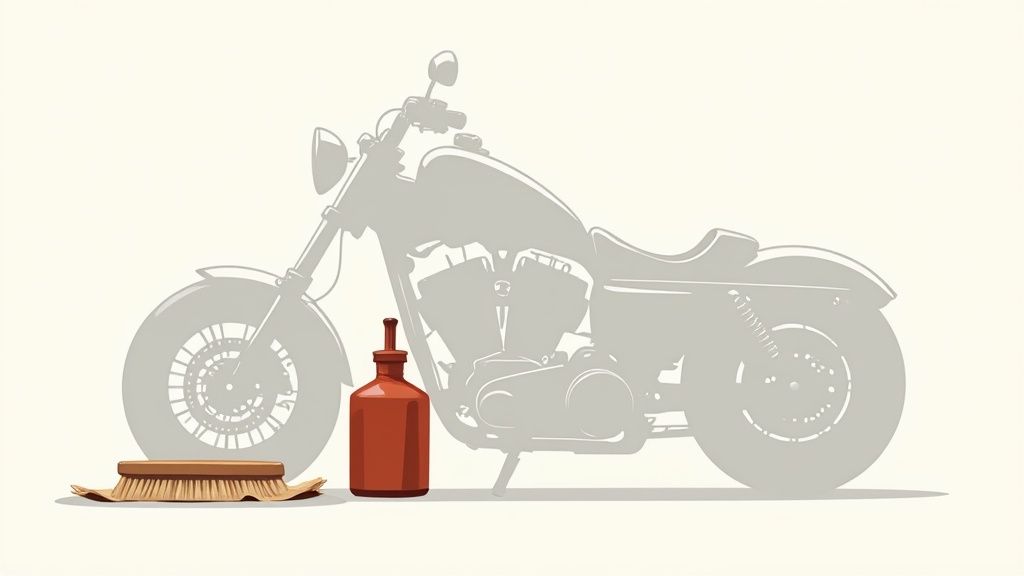
The age-old question for Harley-Davidson owners: wrench or ride? Knowing which maintenance tasks to tackle yourself and which require professional attention is crucial. This informed approach saves you time, money, and potential headaches. Let’s explore how to make the best maintenance decisions for your Harley, considering your skills, budget, and available time.
Simple Tasks, Big Rewards: DIY Maintenance
Some maintenance tasks offer a great return on your time and are perfect for the DIY enthusiast. Checking tire pressure and tread depth, cleaning and lubricating your chain, and checking and topping off fluids are all straightforward. These simple checks can be performed with basic tools and minimal mechanical knowledge. Regularly performing these tasks keeps your Harley running smoothly and helps prevent more serious problems.
Specialized Tools And Expertise: Dealer Advantage
Certain maintenance procedures, however, demand specialized tools and expertise. Adjusting valves, for example, requires specific tools and a deep understanding of engine mechanics. Complex electrical system diagnostics are also best left to trained professionals. Investing in specialized tools for occasional use can be expensive, making a dealer visit the more cost-effective option. This ensures the job is done right, maintaining your Harley-Davidson’s warranty and ensuring its long-term reliability.
Weighing The Risks And Rewards: Warranty Considerations
Your maintenance choices directly affect your warranty coverage. Performing basic maintenance yourself generally won’t void it, but attempting complex repairs without proper training could. An improperly installed part, for instance, can lead to more damage and potential warranty denial. Understanding these implications empowers you to make smart decisions that protect your investment.
Matching Maintenance To Your Lifestyle
Finding the right balance between DIY and dealer maintenance depends on your individual circumstances. If you enjoy working on your bike and are mechanically inclined, handling some maintenance yourself can be rewarding and save you money. You can document your work and keep all your service records organized using a digital tool like Auto Service Logger. Refer to your owner’s manual for specific recommendations for your model year. This meticulous approach will ensure your bike is always road-ready. However, if you’re short on time or prefer to entrust the more complicated procedures to experts, relying on a reputable dealer is a wise choice.
Ultimately, a balanced approach that considers your skill level, available time, and riding priorities is essential. Carefully weighing the risks and rewards of each approach lets you create a maintenance schedule that perfectly suits your needs and keeps your Harley-Davidson in top condition for years to come.
Seasonal Strategies: Adapting Your Harley-Davidson Maintenance Schedule
Your Harley-Davidson, like any machine, feels the effects of weather and seasonal changes. Each season brings unique challenges that can impact your bike’s performance and lifespan. Adapting your maintenance schedule to these seasonal variations is crucial for protecting your investment and ensuring a smooth ride all year round.
Winterizing Your Ride: More Than Just Storage
Winter’s harsh conditions can be particularly damaging. Proper winterization involves more than just storing your bike. Before storing it, change the oil and filter. This removes contaminants that could corrode the engine during storage. Also, fill the fuel tank and add a fuel stabilizer like STA-BIL to prevent fuel degradation and varnish buildup.
Remember to disconnect the battery and store it in a cool, dry location. This prevents freezing and discharging, ensuring a quick start in the spring. Finally, use a breathable cover to protect your bike from dust and moisture. These steps help maintain your Harley’s condition throughout the winter.
Summer Riding: Combating Heat and Humidity
Summer’s heat and humidity present their own challenges. High temperatures can break down fluids faster, while humidity promotes corrosion. During summer, check your oil level frequently and change it as needed. Monitor your cooling system, ensuring the coolant is at the correct level and checking for leaks.
Also, keep a close eye on tire pressure, as heat can cause fluctuations. Inspect your bike’s electrical connections for corrosion, which humidity can accelerate. These proactive checks help ensure your Harley is ready for summer rides.
Fall Maintenance: Preparing For The Cold
Fall is an ideal time to prepare your Harley for the coming winter. This is a crucial time for a final inspection and any necessary repairs. Inspect your brakes, tires, and all fluid levels, taking care of any problems before they worsen.
Fall is also the perfect time for a thorough cleaning and detailing. Removing dirt and grime helps prevent corrosion during storage. Consider a protective coating for vulnerable areas, such as the chrome and paint, shielding them from the elements. Proper fall maintenance makes for a smoother transition into spring.
Recognizing Environmental Factors: Proactive Maintenance
Beyond seasonal changes, other environmental factors can affect your Harley. Coastal riders should be particularly aware of salt air corrosion. Regular washing and protective coatings are essential in these environments.
Riders in dusty or sandy areas should pay attention to their air filters and other components that might clog. By recognizing these environmental factors, you can address them proactively and maintain your Harley’s performance and lifespan.
Properly documenting your maintenance is crucial. Tools like Auto Service Logger can track service intervals, record repairs, and manage all your maintenance information. This lets you create a personalized maintenance schedule that considers your riding conditions, ensuring your bike is always road-ready.
Maintaining Your Harley: Digital Tools for the Modern Rider
Maintaining a Harley-Davidson motorcycle is more than routine oil changes; it’s about preserving a legend and ensuring your bike conquers the open road. Thankfully, technology provides powerful tools to simplify Harley-Davidson maintenance. These digital solutions offer a comprehensive approach that goes beyond simple reminders.
From Greasy Logbooks to Sleek Apps: A Digital Transformation
Remember scribbled notes in a greasy logbook? Those days are fading. Today’s Harley owners use apps and online platforms like Auto Service Logger to track maintenance, record repairs, and even anticipate future needs. This digital shift offers precision and convenience that traditional methods can’t match. Instead of relying on memory, receive automated reminders for upcoming service based on your bike’s mileage.
Essential Features of Digital Maintenance Tools
What should you look for in a maintenance tracking system? Effective tools offer these key features:
- Mileage Tracking: Automatically log rides and receive service alerts based on the Harley-Davidson maintenance schedule.
- Service History Recording: Document every service, repair, and part replacement. This detailed history is invaluable for warranty claims and resale.
- Parts Management: Track when components were last replaced and predict future needs. This proactive approach minimizes unexpected breakdowns.
- Budgeting Tools: Estimate maintenance costs based on your riding habits and planned trips. This helps you manage expenses and plan upgrades.
- Customization: Tailor the platform to your specific Harley-Davidson model and riding style, ensuring the system reflects your bike’s unique requirements.
Real-World Benefits for Harley Riders
Digital tools aren’t just convenient; they enhance your riding experience. Imagine planning a cross-country trip. A digital tool can estimate maintenance needs and costs, ensuring your bike is ready for the adventure. Or, picture having instant access to your bike’s complete service history when diagnosing a problem. This information saves time and empowers informed decisions.
Finding the Perfect Tool for Your Harley
Many excellent options cater to different needs. Some apps specialize in motorcycle maintenance, offering features like tire pressure and fuel economy monitoring. Others offer general vehicle maintenance logging, suitable for riders who also own other vehicles. The key is to find a tool that integrates seamlessly into your life and provides the features you value most.
Auto Service Logger is a comprehensive platform to manage your Harley’s maintenance. With mileage tracking, vehicle-specific reporting, and secure data storage, it simplifies staying on top of your Harley-Davidson maintenance schedule. Learn more about how Auto Service Logger can simplify your Harley-Davidson maintenance at autoservicelogger.com. It’s an investment in your riding future.